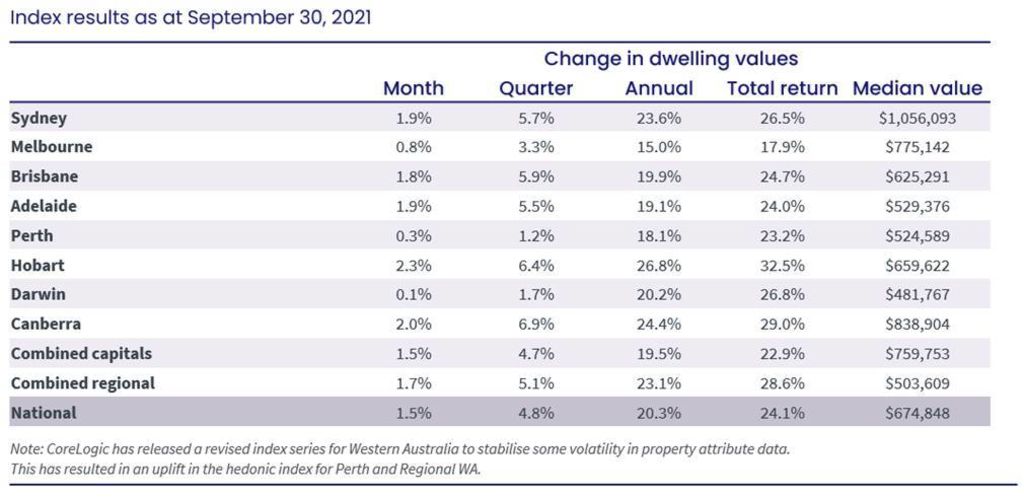Property price hikes continue to slow, but annual growth at highest level in more than 30 years: CoreLogic

Australia’s booming property market has reached record highs in the face of extended lockdowns and growing affordability constraints, resulting in the strongest annual growth in more than 30 years.
Property values climbed more than 20 per cent over the past year nationally, marking the fastest annual growth seen since 1989, the latest CoreLogic National Home Value Index, released Friday, shows, with Sydney up 23.6 per cent and Melbourne up 15 per cent.
However, the pace of monthly price growth continued to slow, with property values rising 1.5 per cent in September to a national median of $674,848 – the lowest rise since January this year, with growth peaking in March at 2.8 per cent.
Home values still climbed in every capital city, reaching record highs in most. Hobart led the charge with a price hike of 2.3 per cent, followed by Canberra (2 per cent) – despite a ban on in-person inspections for much of the month – and Sydney (1.9 per cent). Even in Melbourne, where inspections were also off the cards for part of the month, values rose 0.8 per cent.

Darwin and Perth were the exceptions, with values still below their previous market peaks and more subdued growth of 0.1 per cent and 0.3 per cent, respectively.
Houses continued to outperform units, climbing by 2 per cent or more in Brisbane, Adelaide, Hobart, Canberra and Sydney – with values in the latter two now up a whopping 28 and 28.9 per cent, respectively, over the year.
Across regional Australia, property values lifted 1.7 per cent over September, with values across regional NSW, Victoria, Queensland and Tasmania up by more than 20 per cent annually.
While annual growth was at its strongest level since 1989 – when values climbed 22.6 per cent over the year to June – the market was starting to see a natural slow-down in the cycle, said Eliza Owen, head of research Australia at CoreLogic.
“It comes off the back of the many headwinds starting to emerge for market performance, which includes affordability constraints and stock levels starting to trend a little bit higher,” she said. The report noted lending to owner-occupier first-home buyers had fallen 20.5 per cent between January and July.
“Longer-term I think it will be interesting to see whether consumption patterns [post-lockdowns] whittle down some of the household savings that have contributed to growth in this housing cycle, and the big one will be looming changes to credit conditions.”
The continued price rises come as financial regulators consider introducing tougher lending standards to curb the growing level of debt that house-hunters are taking on, with more than one in five homebuyers now borrowing more than six times their income.
Treasurer Josh Frydenberg has given the green light for them to clamp down on high debt-to-income-ratio loans, and both the OECD and the International Monetary Fund recently called on Australian regulators to cool the market by tightening lending standards, while also suggesting reforms to generous housing-related tax benefits.
Reserve Bank governor Philip Lowe flagged earlier this year that the trigger for macroprudential intervention would be a sustained period where income growth was lower than growth in debt.
“That’s what’s happening now, housing debt has grown 5.6 per cent in the year to June compared to just 1.6 per cent growth in incomes,” Ms Owen said. “So, based on all the hints that have been dropped by various members of the Council of Financial Regulators, it makes sense these interventions would be coming pretty soon.”
Any market intervention would be different to that seen in 2014 and 2017 when regulators targeted investor lending and interest-only loans, Ms Owen said, noting investors now accounted for about 29 per cent of housing finance, compared to the previous cycle’s peak of 45 per cent.
She suspected regulators would introduce a higher serviceability assessment rate – used to assess people’s ability to repay loans if interest rates rise – or limit the proportion of loans that can be issued with a debt-to-income ratio of six or more.
For now, low interest rates and low stock levels continue to put upward pressure on housing values across the country. While the number of homes hitting the market lifted in September – up 15.7 per cent since the recent low point in mid-August – CoreLogic figures show they were still slightly down on the five-year average for this time of year, and the total supply of homes on the market was about 28 per cent below the five-year average.
However, home sales were up about 25.5 per cent on the five-year average, and Ms Owen noted there was more than one sale happening for each listing added to the market.
There are early signs that could be starting change though, said Nicola Powell, Domain’s chief of research and economics, as more homes hit the market – as strong price growth and the return of in-person inspections in Melbourne and Canberra entice more homeowners to sell.
“Prices are still rising, we’ve still got heated markets in many of our capital cities … but what we’re not seeing is the level of competitive conditions we were seeing earlier in the year … which were so rare and so unusual,’ Dr Powell said.
In Sydney, Dr Powell noted, the number of homes for sale had been shrinking for some time, as properties were snapped up quicker than they could come to the market, depleting overall stock levels. However total supply now looks to be tracking slightly higher, suggesting new listings could be starting to outpace demand which would help ease price growth.
At the same time demand was being impacted by affordability constraints, Dr Powell said. First-home buyer activity was the hardest hit by rapid price raises, but the growth could also take a toll on the number of people looking to upsize, she noted.
“When you have an environment where housing credit and house price growth is outpacing wages that’s a real affordably issue and why we’ve now got greater conversations happening around placing restrictions on lending,” she said.
A crackdown on debt-to-income ratio would hit single-income buyers and first-home buyers, Dr Powell said, noting care would need to be taken to ensure tougher lending standards were not too detrimental to first-home buyer activity.
We recommend
States
Capital Cities
Capital Cities - Rentals
Popular Areas
Allhomes
More









